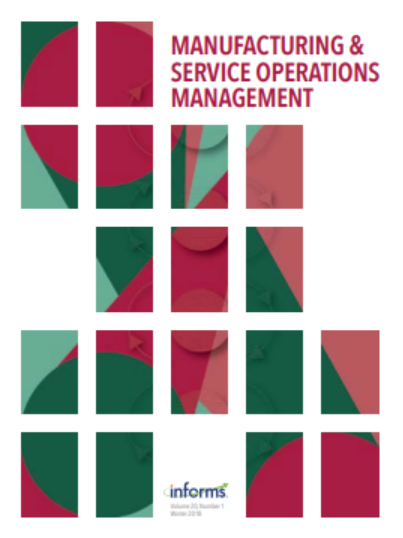Inventory-Responsive Donor-Management Policy: A Tandem Queueing Network Model
IF 4.2
3区 管理学
Q1 MANAGEMENT
M&som-Manufacturing & Service Operations Management
Pub Date : 2023-07-01
DOI:10.1287/msom.2023.1228
引用次数: 0
Abstract
Problem definition: In the blood-donor-management problem, the blood bank incentivizes donors to donate, given blood inventory levels. We propose a model to optimize such incentivization schemes under the context of random demand, blood perishability, observation period between donations, and variability in donor arrivals and dropouts. Methodology/results: We propose an optimization model that simultaneously accounts for the dynamics in the blood inventory and the donor’s donation process, as a coupled queueing network. We adopt the Pipeline Queue paradigm, which leads us to a tractable convex reformulation. The coupled setting requires new methodologies to be developed upon the existing Pipeline Queue framework. Numerical results demonstrate the advantages of the optimal policy by comparing it with the commonly adopted and studied threshold policy. Our optimal policy can effectively reduce both shortages and wastage. Managerial implications: Our model is the first to operationalize a dynamic donor-incentivization scheme, by determining the optimal number of donors of different donation responsiveness to receive each type of incentive. It can serve as a decision-support tool that incorporates practical features of blood supply-chain management not addressed thus far, to the best of our knowledge. Simulations on existing policies indicate the dangers of myopic approaches and justify the need for smoother and forward-looking donor-incentivization schedules that can hedge against future demand variation. Our model also has potential wider applications in supply chains with perishable inventory. Funding: This study was funded by the Singapore Management University through a research [Grant 20-C207-SMU-015] from the Ministry of Education Academic Research Fund Tier 1. Supplemental Material: The online appendix is available at https://doi.org/10.1287/msom.2023.1228 .库存响应供方管理策略:串联排队网络模型
问题定义:在献血者管理问题中,血库在给定血液库存水平的情况下激励献血者献血。我们提出了一个模型,在随机需求、血液易腐性、捐赠之间的观察期以及捐赠者到达和退出的可变性的背景下,优化这种激励方案。方法/结果:我们提出了一个优化模型,同时考虑了血液库存和献血者捐赠过程的动态,作为一个耦合排队网络。我们采用管道队列范式,这使我们得到了一个易于处理的凸重构。耦合设置需要在现有的Pipeline Queue框架上开发新的方法。数值结果表明,与常用的阈值策略相比,该策略具有较好的优越性。我们的最优政策可以有效地减少短缺和浪费。管理意义:我们的模型是第一个实现动态捐赠者激励方案的模型,通过确定接受每种激励的不同捐赠响应的捐赠者的最佳数量。据我们所知,它可以作为一种决策支持工具,结合迄今为止尚未解决的血液供应链管理的实际特点。对现有政策的模拟表明了短视做法的危险,并证明有必要制定更顺畅和前瞻性的捐助者激励计划,以对冲未来的需求变化。我们的模型在具有易腐库存的供应链中也有更广泛的应用潜力。本研究由新加坡管理大学通过教育部学术研究基金第一梯队的研究[Grant 20-C207-SMU-015]资助。补充材料:在线附录可在https://doi.org/10.1287/msom.2023.1228上获得。
本文章由计算机程序翻译,如有差异,请以英文原文为准。
求助全文
约1分钟内获得全文
求助全文
来源期刊

M&som-Manufacturing & Service Operations Management
管理科学-运筹学与管理科学
CiteScore
9.30
自引率
12.70%
发文量
184
审稿时长
12 months
期刊介绍:
M&SOM is the INFORMS journal for operations management. The purpose of the journal is to publish high-impact manuscripts that report relevant research on important problems in operations management (OM). The field of OM is the study of the innovative or traditional processes for the design, procurement, production, delivery, and recovery of goods and services. OM research entails the control, planning, design, and improvement of these processes. This research can be prescriptive, descriptive, or predictive; however, the intent of the research is ultimately to develop some form of enduring knowledge that can lead to more efficient or effective processes for the creation and delivery of goods and services.
M&SOM encourages a variety of methodological approaches to OM research; papers may be theoretical or empirical, analytical or computational, and may be based on a range of established research disciplines. M&SOM encourages contributions in OM across the full spectrum of decision making: strategic, tactical, and operational. Furthermore, the journal supports research that examines pertinent issues at the interfaces between OM and other functional areas.
 求助内容:
求助内容: 应助结果提醒方式:
应助结果提醒方式:


